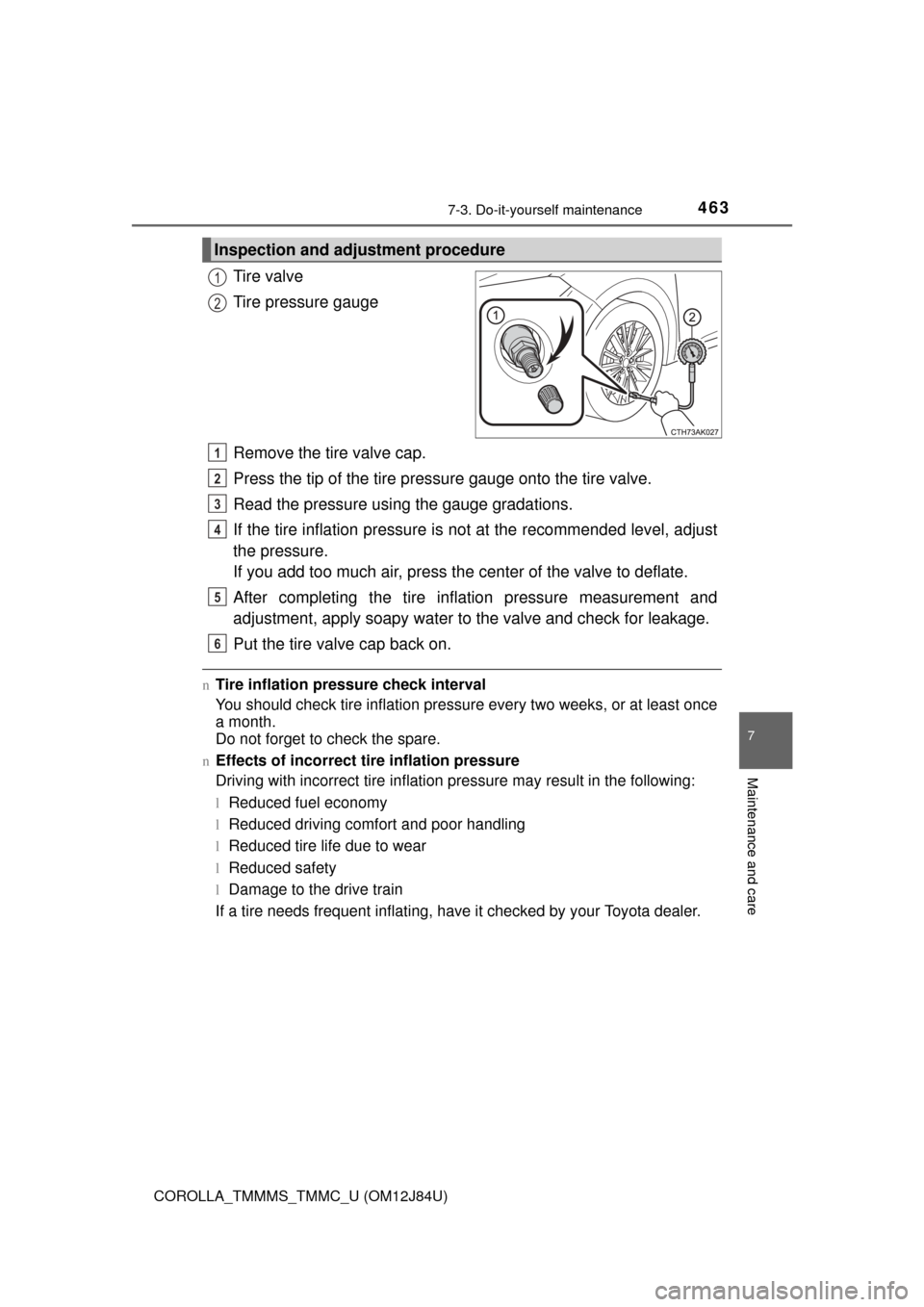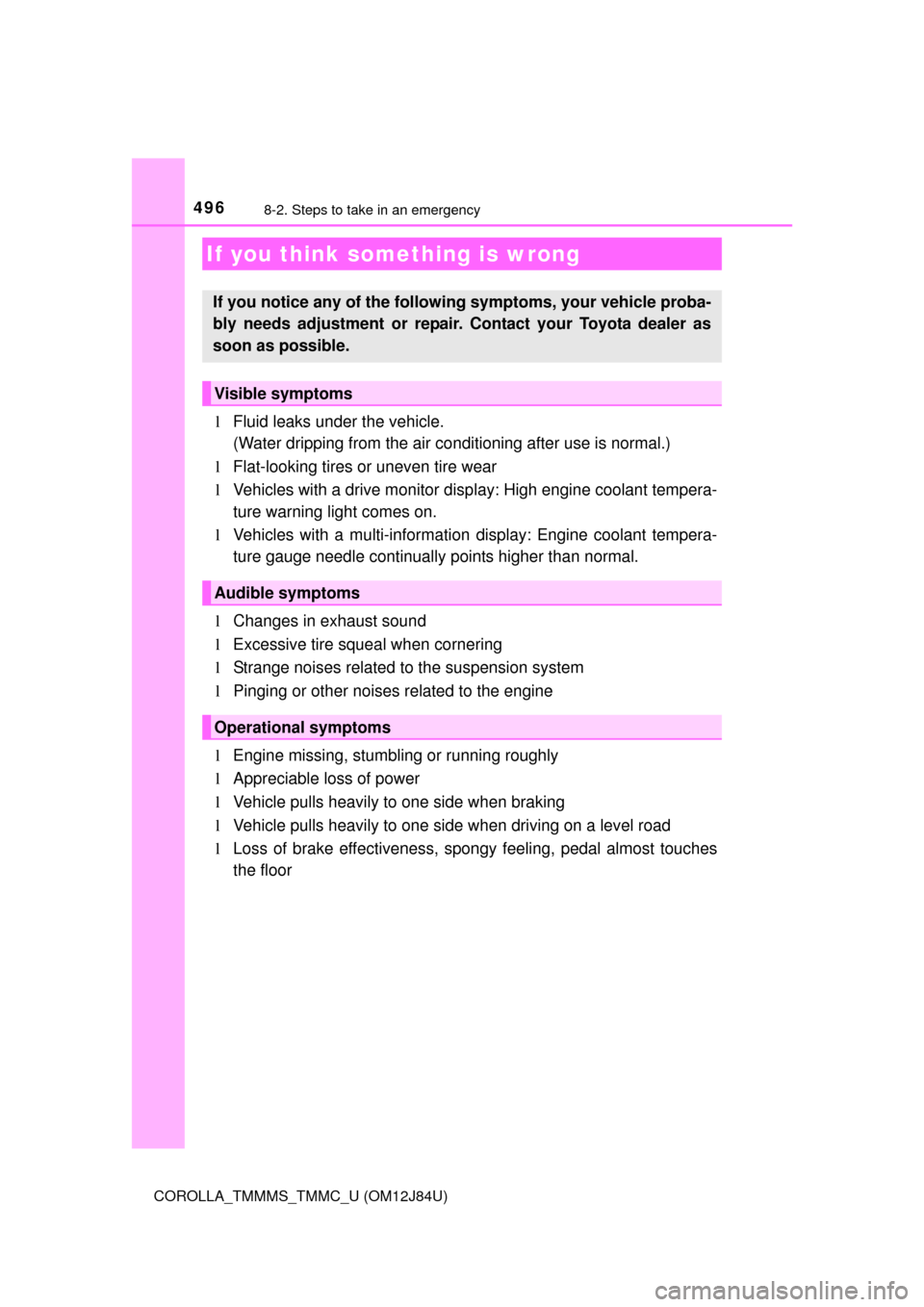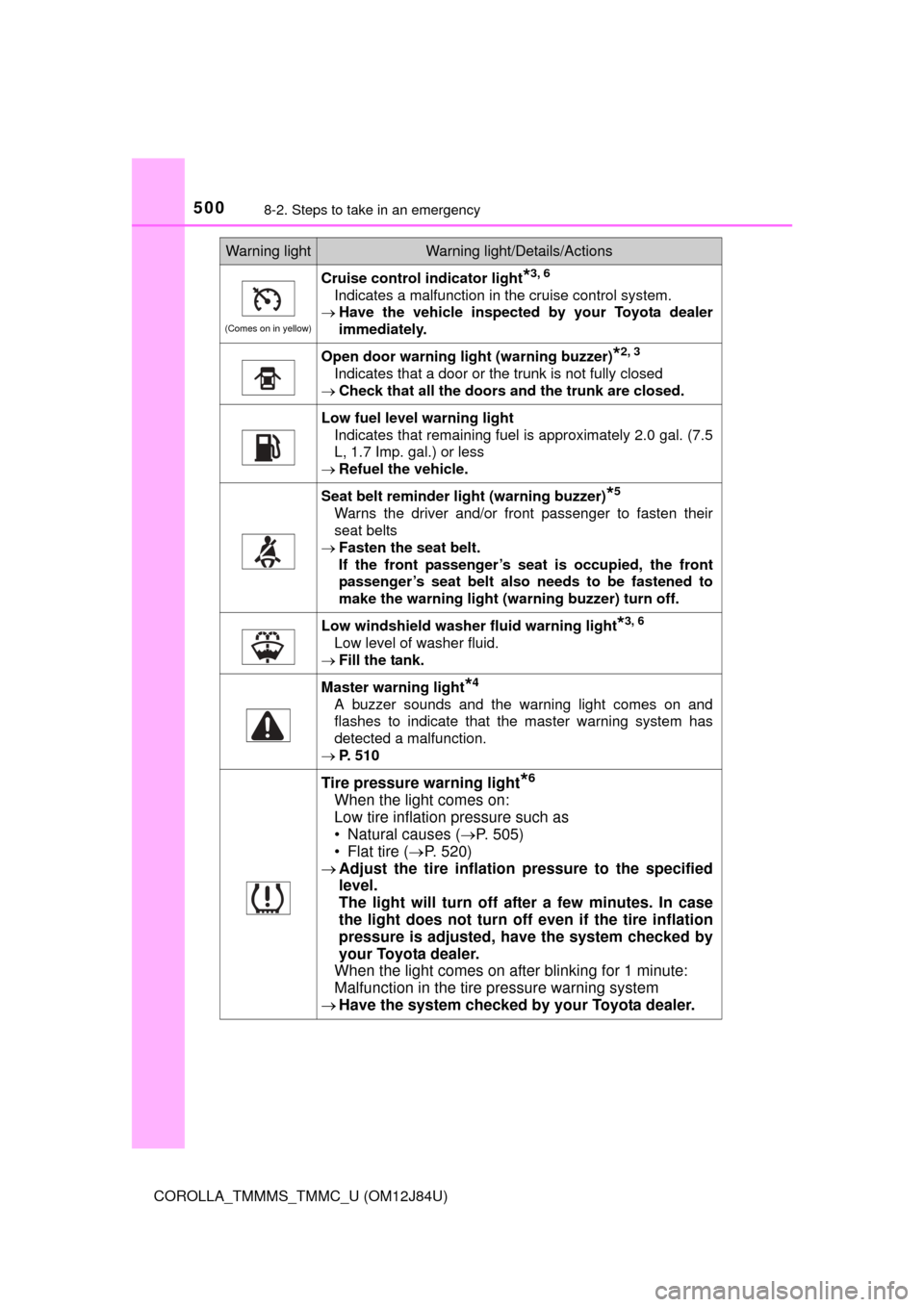2016 TOYOTA COROLLA flat tire
[x] Cancel search: flat tirePage 463 of 620

4637-3. Do-it-yourself maintenance
7
Maintenance and care
COROLLA_TMMMS_TMMC_U (OM12J84U)
Tire valve
Tire pressure gauge
Remove the tire valve cap.
Press the tip of the tire pressure gauge onto the tire valve.
Read the pressure usi ng the gauge gradations.
If the tire inflation pressure is not at the recommended level, adjust
the pressure.
If you add too much air, press the center of the valve to deflate.
After completing the tire inflation pressure measurement and
adjustment, apply soapy water to the valve and check for leakage.
Put the tire valve cap back on.
nTire inflation pressure check interval
You should check tire inflation pressure every two weeks, or at least once
a month.
Do not forget to check the spare.
nEffects of incorrect tire inflation pressure
Driving with incorrect tire inflation pressure may result in the following:
lReduced fuel economy
lReduced driving comfort and poor handling
lReduced tire life due to wear
lReduced safety
lDamage to the drive train
If a tire needs frequent inflating, have it checked by your Toyota dealer.
Inspection and adjustment procedure
1
2
1
2
3
4
5
6
Page 464 of 620

4647-3. Do-it-yourself maintenance
COROLLA_TMMMS_TMMC_U (OM12J84U)n
Instructions for checking tire inflation pressure
When checking tire inflation pressure, observe the following:
lCheck only when the tires are cold.
If your vehicle has been parked for at least 3 hours or has not been
driven for more than 1 mile or 1.5 km, you will get an accurate cold tire
inflation pressure reading.
lAlways use a tire pressure gauge.
It is difficult to judge if a tire is properly inflated based only on its appear-
ance.
lIt is normal for the tire inflation pressure to be higher after driving as
heat is generated in the tire. Do not
reduce tire inflation pressure after
driving.
lNever exceed the vehicle capacity weight.
Passengers and luggage weight should be placed so that the vehicle is
balanced.
CAUTION
nProper inflation is critical to save tire performance
Keep your tires properly inflated.
If the tires are not properly inflated, the following conditions may occur
which could lead to an accident resulting in death or serious injury:
lExcessive wear
lUneven wear
lPoor handling
lPossibility of blowouts result ing from overheated tires
lAir leaking from between tire and wheel
lWheel deformation and/or tire damage
lGreater possibility of tire damage while driving (due to road hazards,
expansion joints, sharp edges in the road, etc.)
NOTICE
nWhen inspecting and adjusting tire inflation pressure
Be sure to put the tire valve caps back on.
If a valve cap is not installed, dirt or moisture may get into the valve and
cause an air leak, resulting in decreased tire inflation pressure.
Page 465 of 620

4657-3. Do-it-yourself maintenance
7
Maintenance and care
COROLLA_TMMMS_TMMC_U (OM12J84U)
When replacing wheels, care should be taken to ensure that they are
equivalent to those removed in load capacity, diameter, rim width and
inset
*.
Replacement wheels are available at your Toyota dealer.
*: Conventionally referred to as “offset”.
Toyota does not recommend using the following:
l Wheels of different sizes or types
l Used wheels
l Bent wheels that have been straightened
l Use only Toyota wheel nuts and wrenches designed for use with
your aluminum wheels.
l When rotating, repairing or changi ng your tires, check that the
wheel nuts are still tight after driving 1000 miles (1600 km).
l Be careful not to damage the aluminum wheels when using tire
chains.
l Use only Toyota genuine balance weights or equivalent and a plas-
tic or rubber hammer when balancing your wheels.
nWhen replacing wheels (vehicles with a tire pressure warning sys-
tem)
The wheels of your vehicle are equipped with tire pressure warning
valves and transmitters that allow the tire pressure warning system to
provide advance warning in the event of a loss in tire inflation pressure.
Whenever wheels are replaced, tire pressure warning valves and trans-
mitters must be installed. ( P. 455)
Wheels
If a wheel is bent, cracked or heavily corroded, it should be
replaced. Otherwise, the tire may separate from the wheel or
cause a loss of handling control.
Wheel selection
Aluminum wheel precautions (if equipped)
Page 487 of 620

487
8When trouble arises
COROLLA_TMMMS_TMMC_U (OM12J84U)8-1. Essential information
Emergency flashers .......... 488
If your vehicle has to be stopped in an
emergency ...................... 489 8-2. Steps to take in an
emergency
If your vehicle needs to be towed ......................... 491
If you think something is wrong .............................. 496
Fuel pump shut off system ............................ 497
If a warning light turns on or a warning buzzer
sounds ............................ 498
If a warning message or indicator is
displayed ......................... 510
If you have a flat tire.......... 520
If the engine will not start ................................. 532
If the shift lever cannot be shifted from P ............. 534
If the electronic key does not operate
properly ........................... 535
If the vehicle battery is discharged ...................... 538
If your vehicle overheats ........................ 543
If the vehicle becomes stuck ............................... 547
Page 496 of 620

4968-2. Steps to take in an emergency
COROLLA_TMMMS_TMMC_U (OM12J84U)
lFluid leaks under the vehicle.
(Water dripping from the air co nditioning after use is normal.)
l Flat-looking tires or uneven tire wear
l Vehicles with a drive monitor display: High engine coolant tempera-
ture warning light comes on.
l Vehicles with a multi-information display: Engine coolant tempera-
ture gauge needle continually points higher than normal.
l Changes in exhaust sound
l Excessive tire squeal when cornering
l Strange noises related to the suspension system
l Pinging or other noises related to the engine
l Engine missing, stumbling or running roughly
l Appreciable loss of power
l Vehicle pulls heavily to one side when braking
l Vehicle pulls heavily to one side when driving on a level road
l Loss of brake effectiveness, spon gy feeling, pedal almost touches
the floor
If you think something is wrong
If you notice any of the follow ing symptoms, your vehicle proba-
bly needs adjustment or repair. Contact your Toyota dealer as
soon as possible.
Visible symptoms
Audible symptoms
Operational symptoms
Page 500 of 620

5008-2. Steps to take in an emergency
COROLLA_TMMMS_TMMC_U (OM12J84U)
(Comes on in yellow)
Cruise control indicator light*3, 6
Indicates a malfunction in the cruise control system.
Have the vehicle inspected by your Toyota dealer
immediately.
Open door warning light (warning buzzer)*2, 3
Indicates that a door or the trunk is not fully closed
Check that all the doors and the trunk are closed.
Low fuel level warning light
Indicates that remaining fuel is approximately 2.0 gal. (7.5
L, 1.7 Imp. gal.) or less
Refuel the vehicle.
Seat belt reminder light (warning buzzer)*5
Warns the driver and/or front passenger to fasten their
seat belts
Fasten the seat belt.
If the front passenger’s seat is occupied, the front
passenger’s seat belt also needs to be fastened to
make the warning light (war ning buzzer) turn off.
Low windshield washer fluid warning light*3, 6
Low level of washer fluid.
Fill the tank.
Master warning light*4
A buzzer sounds and the warning light comes on and
flashes to indicate that the master warning system has
detected a malfunction.
P. 510
Tire pressure warning light*6
When the light comes on:
Low tire inflation pressure such as
• Natural causes ( P. 505)
• Flat tire ( P. 520)
Adjust the tire inflation pressure to the specified
level.
The light will turn off after a few minutes. In case
the light does not turn off even if the tire inflation
pressure is adjusted, have the system checked by
your Toyota dealer.
When the light comes on after blinking for 1 minute:
Malfunction in the tire pressure warning system
Have the system checked by your Toyota dealer.
Warning lightWarning light/Details/Actions
Page 505 of 620

5058-2. Steps to take in an emergency
8
When trouble arises
COROLLA_TMMMS_TMMC_U (OM12J84U)
nSRS warning light
This warning light system monitors the airbag sensor assembly, front impact
sensors, side impact sensors (front door), side impact sensors (front), side
impact sensors (rear), driver’s seat belt buckle switch, front passenger occu-
pant classification system, “AIR BAG ON” indicator light, “AIR BAG OFF” indi-
cator light, front passenger’s seat belt buckle switch, seat belt pretensioners
(front), airbags, interconnecting wiring and power sources. ( P. 3 5 )
n Front passenger detection sensor, seat belt reminder and warning
buzzer
If luggage is placed on the front passenger seat, the front passenger detec-
tion sensor may cause the warning light to flash and the warning buzzer to
sound even if a passenger is not sitting in the seat.
n If the malfunction indicator la mp comes on while driving
First check the following:
l Is the fuel tank empty?
If it is, fill the fuel tank immediately.
l Is the fuel tank cap loose?
If it is, tighten it securely.
The light will go off after several driving trips.
If the light does not go off even after several trips, contact your Toyota dealer
as soon as possible.
n
When the tire pressure warning light comes on (vehicles with a tire
pressure warning system)
Check the tire inflation pressure and adjust to the appropriate level. Push-
ing the tire pressure warning reset switch will not turn off the tire pressure
warning light.
nThe tire pressure warning light may come on due to natural causes
(vehicles with a tire pressure warning system)
The tire pressure warning light may come on due to natural causes such
as natural air leaks and tire inflation pressure changes caused by temper-
ature. In this case, adjusting the ti re inflation pressure will turn off the
warning light (after a few minutes).
Page 506 of 620

5068-2. Steps to take in an emergency
COROLLA_TMMMS_TMMC_U (OM12J84U)n
When a tire is replaced with a spare tire (vehicles with a tire pressure
warning system)
The compact spare tire is not equipped with a tire pressure warning valve
and transmitter. If a tire goes flat,
the tire pressure warning light will not
turn off even though the flat tire has been replaced with the spare tire.
Replace the spare tire with the repaired tire and adjust the tire inflation
pressure. The tire pressu re warning light will go off after a few minutes.
nConditions that the tire pressure warning system may not function
properly (vehicles with a tire pressure warning system)
The tire pressure warning system will be disabled in the following condi-
tions:
(When the condition be comes normal, the system will work properly.)
lIf tires not equipped with tire pressure warning valves and transmitters
are used
lIf the ID code on the tire pressure warning valves and transmitters is not
registered in the tire pressure warning computer
lIf the tire inflation pressure is 73 psi (500 kPa, 5.1 kgf/cm2 or bar) or
higher
The tire pressure warning system may be disabled in the following condi-
tions:
(When the condition be comes normal, the system will work properly.)
lIf electronic devices or facilities using similar radio wave frequencies are
nearby
lIf a radio set at similar frequency is in use in the vehicle
lIf a window tint that affects the radio wave signals is installed
lIf there is a lot of snow or ice on th e vehicle, in particular around the
wheels or wheel housings
lIf non-genuine Toyota wheels are used (Even if you use Toyota wheels,
the tire pressure warning system may not work properly with some types
of tires.)
lIf tire chains are used
nIf the tire pressure warning light frequently comes on after blinking
for 1 minute (vehicles with a tire pressure warning system)
If the tire pressure warning light frequently comes on after blinking for 1
minute when the engine switch is turned on, have it checked by your
Toyota dealer.
n Warning buzzer
In some cases, the buzzer may not be heard because of noisy place or an
audio sound.
n Electric power steering system warning light (warning buzzer)
When the battery charge becomes insufficient or the voltage temporarily
drops, the electric power steering system warning light may come on and the
warning buzzer may sound.